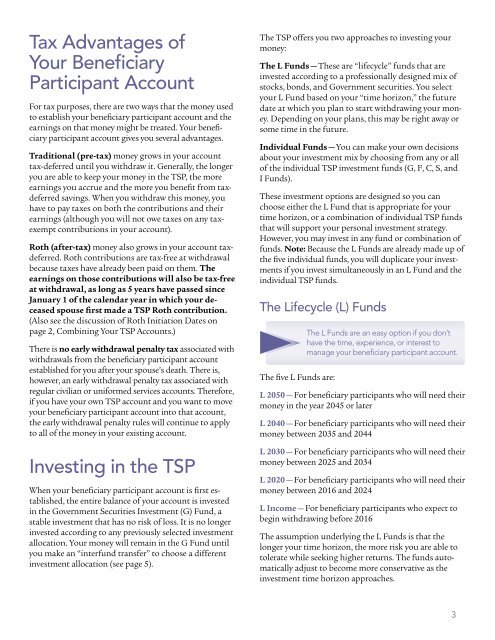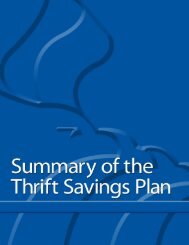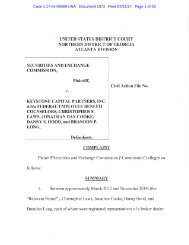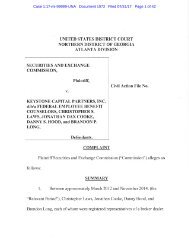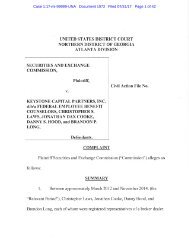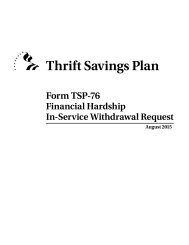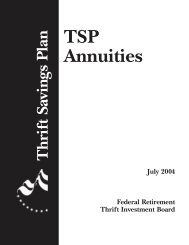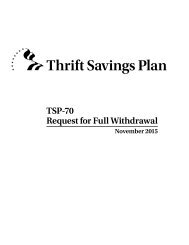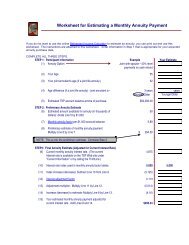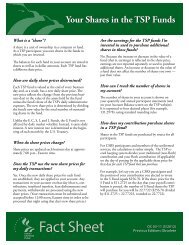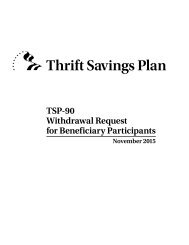tspbk33
Create successful ePaper yourself
Turn your PDF publications into a flip-book with our unique Google optimized e-Paper software.
Tax Advantages of<br />
Your Beneficiary<br />
Participant Account<br />
For tax purposes, there are two ways that the money used<br />
to establish your beneficiary participant account and the<br />
earnings on that money might be treated. Your beneficiary<br />
participant account gives you several advantages.<br />
Traditional (pre-tax) money grows in your account<br />
tax-deferred until you withdraw it. Generally, the longer<br />
you are able to keep your money in the TSP, the more<br />
earnings you accrue and the more you benefit from taxdeferred<br />
savings. When you withdraw this money, you<br />
have to pay taxes on both the contributions and their<br />
earnings (although you will not owe taxes on any taxexempt<br />
contributions in your account).<br />
Roth (after-tax) money also grows in your account taxdeferred.<br />
Roth contributions are tax-free at withdrawal<br />
because taxes have already been paid on them. The<br />
earnings on those contributions will also be tax-free<br />
at withdrawal, as long as 5 years have passed since<br />
January 1 of the calendar year in which your deceased<br />
spouse first made a TSP Roth contribution.<br />
(Also see the discussion of Roth Initiation Dates on<br />
page 2, Combining Your TSP Accounts.)<br />
There is no early withdrawal penalty tax associated with<br />
withdrawals from the beneficiary participant account<br />
established for you after your spouse’s death. There is,<br />
however, an early withdrawal penalty tax associated with<br />
regular civilian or uniformed services accounts. Therefore,<br />
if you have your own TSP account and you want to move<br />
your beneficiary participant account into that account,<br />
the early withdrawal penalty rules will continue to apply<br />
to all of the money in your existing account.<br />
Investing in the TSP<br />
When your beneficiary participant account is first established,<br />
the entire balance of your account is invested<br />
in the Government Securities Investment (G) Fund, a<br />
stable investment that has no risk of loss. It is no longer<br />
invested according to any previously selected investment<br />
allocation. Your money will remain in the G Fund until<br />
you make an “interfund transfer” to choose a different<br />
investment allocation (see page 5).<br />
The TSP offers you two approaches to investing your<br />
money:<br />
The L Funds — These are “lifecycle” funds that are<br />
invested according to a professionally designed mix of<br />
stocks, bonds, and Government securities. You select<br />
your L Fund based on your “time horizon,” the future<br />
date at which you plan to start withdrawing your money.<br />
Depending on your plans, this may be right away or<br />
some time in the future.<br />
Individual Funds — You can make your own decisions<br />
about your investment mix by choosing from any or all<br />
of the individual TSP investment funds (G, F, C, S, and<br />
I Funds).<br />
These investment options are designed so you can<br />
choose either the L Fund that is appropriate for your<br />
time horizon, or a combination of individual TSP funds<br />
that will support your personal investment strategy.<br />
However, you may invest in any fund or combination of<br />
funds. Note: Because the L Funds are already made up of<br />
the five individual funds, you will duplicate your investments<br />
if you invest simultaneously in an L Fund and the<br />
individual TSP funds.<br />
The Lifecycle (L) Funds<br />
The five L Funds are:<br />
The L Funds are an easy option if you don’t<br />
have the time, experience, or interest to<br />
manage your beneficiary participant account.<br />
L 2050 — For beneficiary participants who will need their<br />
money in the year 2045 or later<br />
L 2040 — For beneficiary participants who will need their<br />
money between 2035 and 2044<br />
L 2030 — For beneficiary participants who will need their<br />
money between 2025 and 2034<br />
L 2020 — For beneficiary participants who will need their<br />
money between 2016 and 2024<br />
L Income — For beneficiary participants who expect to<br />
begin withdrawing before 2016<br />
The assumption underlying the L Funds is that the<br />
longer your time horizon, the more risk you are able to<br />
tolerate while seeking higher returns. The funds automatically<br />
adjust to become more conservative as the<br />
investment time horizon approaches.<br />
3


